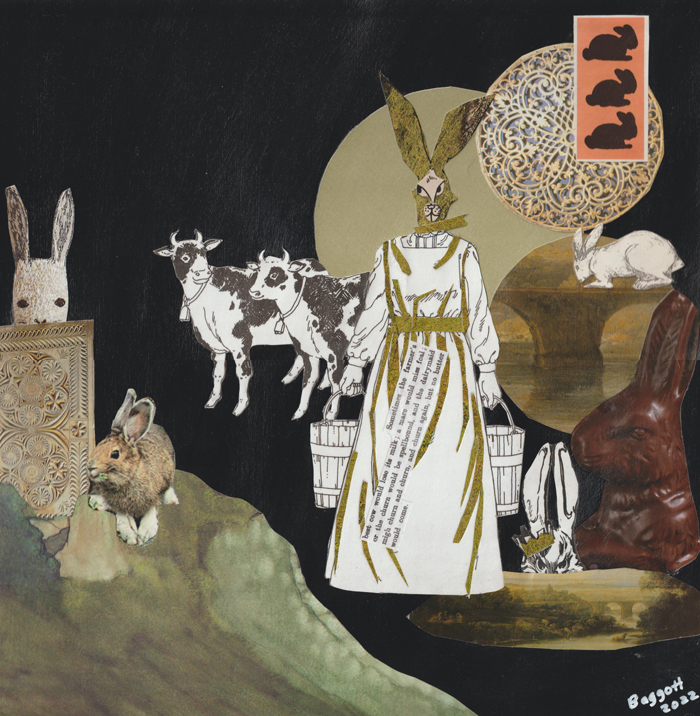
12″x12″; collage of magazine and book fragments on cardstock with matte medium and mod podge; 2022. Courtesy of the artist.
NEW PUBLICATION
Folklore of the Upper Nithsdale: Stories of Witches, Ghosts, & Other Spirits from Sanquhar, Scotland
Thirty-three collage artists illustrate stories of witches, ghosts, and other spirits from Sanquhar, Scotland. Using stories collected from William Wilson’s 1904 book, artists reimagine these tales in a 21st Century context and invite us to see folklore as the imagination of the past, understood in the present. The book includes an introduction by Ric Kasini Kadour.
PURCHASE THE BOOK
In his introduction to the 1904 edition, Wilson wrote about Sanquhar’s penchant for wild tales. “The peaceful valley,” he wrote, “appears to have had a peculiar attraction for beings supernatural; and for generations its bosky glens and leafy braes have been the reputed haunt of ghosts, fairies, witches, and other beings of an uncanny kind. This sweet, pastoral vale in its nine miles course can boast of scenery unequaled in its quiet beauty, possessing in its woods and waters, its hazelly glens and green-clad hills, everything that can contribute to the making of the finest landscape, while to increase the charm it abounds in the most romantic tales of byegone days. The following sketches, traditions, and reminiscences of by-gone days were penned originally for the local press—some of them as far back as twenty years ago—solely with a view to rescue from oblivion much that is curious and interesting, and known only to us of the older generation.”
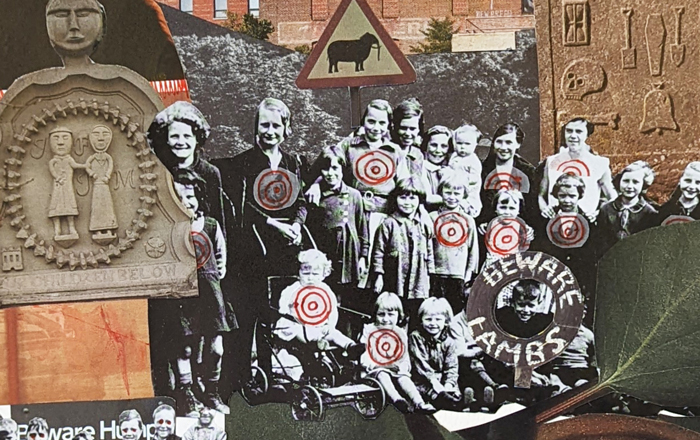
18″x12″; collage of magazine cut-outs, vintage book paper, and printed photographs, pencil on watercolor paper; 2022. Courtesy of the artist.
As Wilson sought “to rescue from oblivion” these stories, Kolaj Institute is interested in considering the value of these stories to a 21st century reader. In September 2022, Kolaj Institute organised a series of collage artist residencies held at MERZ in Sanquhar. The participating artists–who came from The Bahamas, Belgium, Canada, Switzerland, the United States, and the United Kingdom–worked throughout the residencies to create artwork in response to Wilson’s text. Using the rural community as a laboratory, they learned about the place, its people, and its history; and discussed how art can capture, share, reflect, comment, and otherwise engage with a sense of place. The goal of the residency was to develop an individual methodology for responding to place in one’s art practice and to make a work of art about Sanquhar that speaks to and about the people and land. Our hope was that artists would return to their home communities with fresh eyes and be prepared to see their communities in a unique way. In the afternoons, artists made art or took up an afternoon activity such as a walk to the River Nith and castle or a visit to the Tolbooth Museum or Saint Bride’s church or an afternoon trip via rail to Dumfries or Glasgow. In the evenings, we convened at the Nithsdale Pub to informally share the experience of our days. During the residency, artists made artwork that was exhibited at MERZ Gallery as part of “Mythical Landscape: Secrets of the Vale.” The exhibition travelled to the Knoxville Museum of Art in Tennessee where it is on view until 7 May 2023.
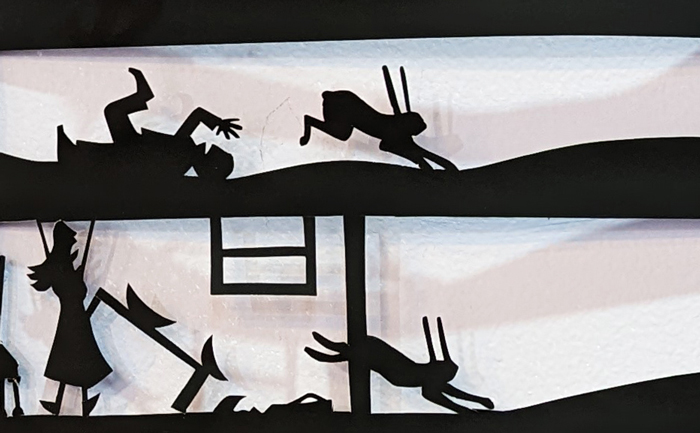
15″x10″; silhouette paper and washi tape; 2022. Courtesy of the artist.
About the Book
In this book, Folklore of the Upper Nithsdale: Stories of Witches, Ghosts, & Other Spirits from Sanquhar, Scotland, Kolaj Institute presents selections of artwork paired with some of Wilson’s original texts. The artists brought to Sanquhar a perspective from outside the culture they were now engaging. They were also operating from a 21st century vantage point, a view informed by nearly a century where folklore was academically studied and taught. The transformation was radical. No longer a way to explain the eerie sound the wind makes as it crosses the valley, Philadelphia, Pennsylvania artist Dafna Steinberg thought of ghost stories as an expression of the unresolved trauma of a community. A number of artists saw the frequent stores of female ghosts as a community wrestling with violence against women. Aimée Henny Brown from New Westminster, British Columbia, was drawn to the repeated mention of stone in the stories. While never the focal subject of a story, she chose to make a work that illustrated its importance. Chattanooga, Tennessee artist Ron Buffington responded to Sanquhar’s kirkyard and designed a series of banners which showed the backs of headstones as a way to draw our attention to historical amnesia. San Francisco, California artist Michelle Echenique turned an empty cat food box into a whimsical reflection on the Queen’s life, in light of the fact that she passed away during the artists’ residency. A number of artists read the stories of witches and rather than seeing them through Wilson’s lens as “uncanny beings who by entering into a compact with the Evil One” choose to see them as beacons of women’s empowerment. The work of Denver, Colorado artist Jennifer Evans imagines a sisterhood of witches turning themselves into hares and frolicking by the river as their laundry was drying. Hamilton, Massachusetts artist Gregory Deddo makes a connection between the region’s history of coal mining, its continued mark on the environment, and the story of wraiths. In doing this, the artists are making suggestions about why these stories continue to matter today.

18″x24″; pigment printed photographs; 2022. Courtesy of the artist.
“Folklore is how we communicate to each other our morals, ideals, hopes, and fears. It’s how we make meaning or sense of the world around us,” said Kolaj Institute coordinator Christopher Kurts. “Maybe this is true of stories in general, but folklore are the stories that hold enough water with a community to keep being passed down. They have momentum and so they change from being these ephemeral tales and solidify into a kind of mythology or foundation.” By engaging with these stories, artists can play a role in activating folklore for a community and facilitating their transmission.
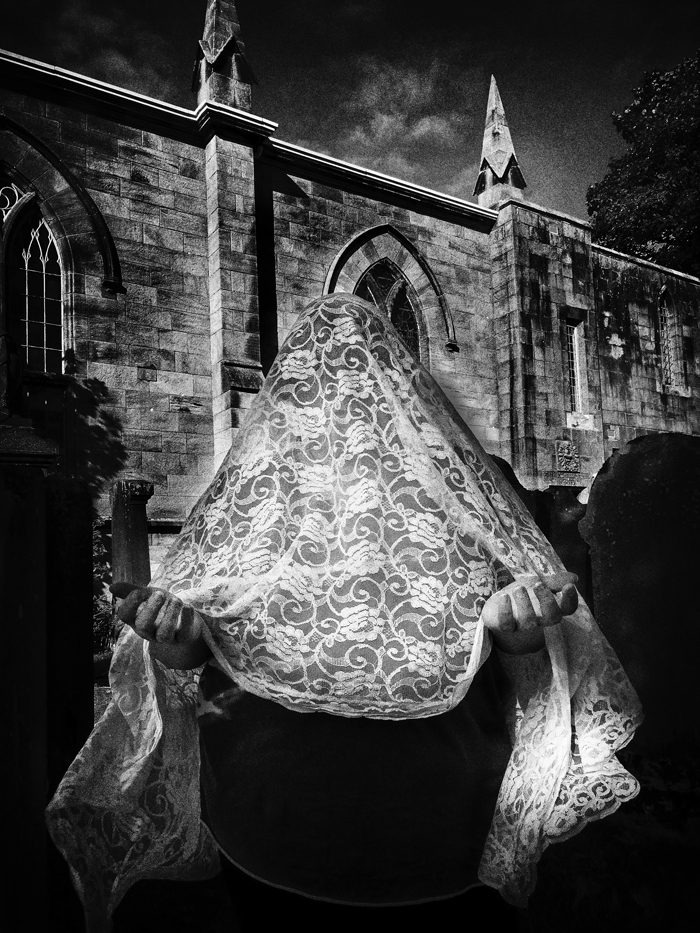
32″x24″; digital photographic print; 2022. Courtesy of the artist.
During a time when folklore is devalued by economic systems and dismissed by political power, artists play an important role in calling attention to and celebrating these important elements that shape community identity and reinforce communal ties. In times of crisis and collective trauma, these stories can be key to a community’s sense of resilience and ultimate survival.
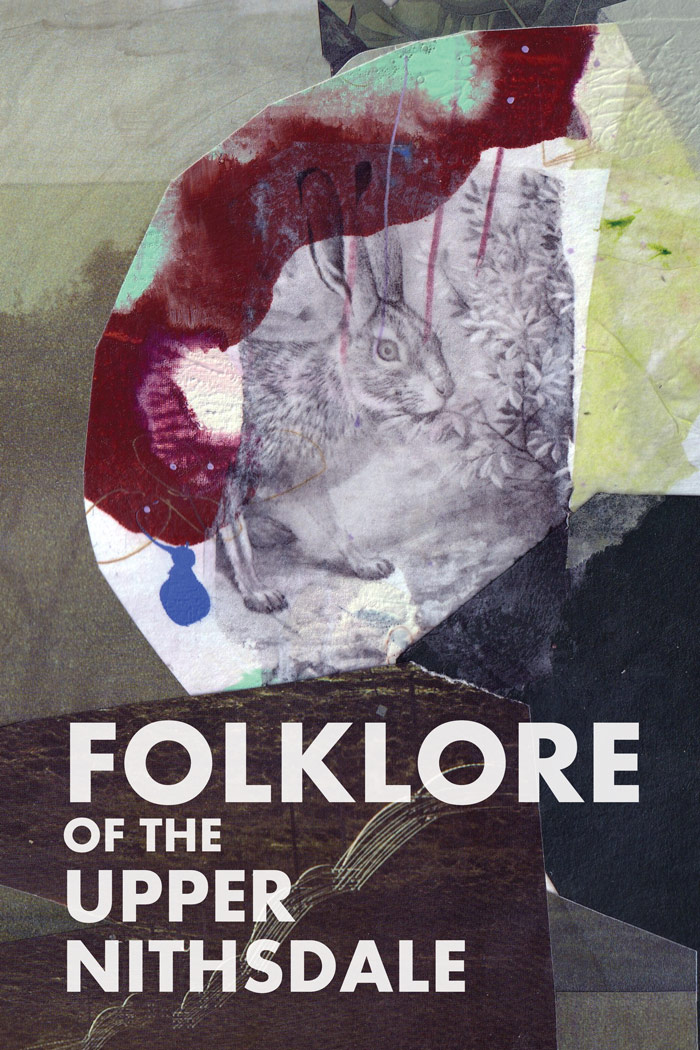
PURCHASE THE BOOK
Folklore of the Upper Nithsdale is the current Silver Scissors & Golden Glue Item
Join the Silver Scissors or Golden Glue Society before 15 April 2023 and receive Folklore of the Upper Nithsdale as the first of many publications from Kolaj Institute while supporting our mission to support artists, curators, and writers who seek to study, document, and disseminate ideas that deepen our understanding of collage as a medium, a genre, a community, and a 21st century movement.
To join the Silver Scissors or Golden Glue Societies, go HERE.
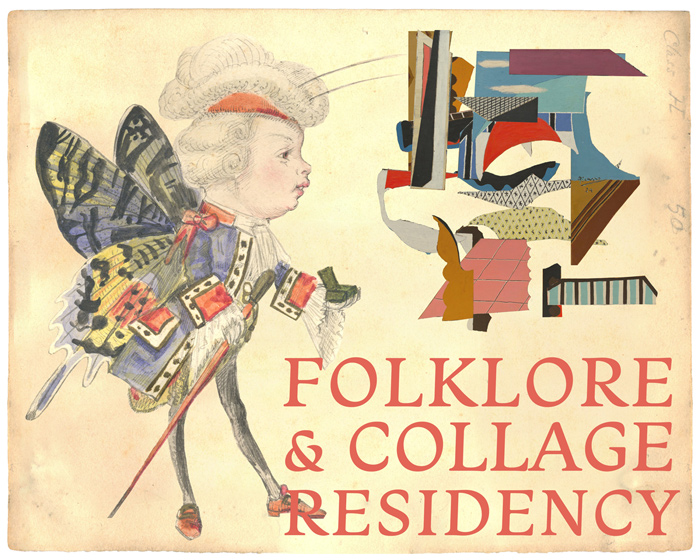
Interested in making collage about folklore?
Apply to Kolaj Institute’s Folklore & Collage Residency: Virtual, taking place 20 June-13 July 2023. Read the Call to Artists HERE.
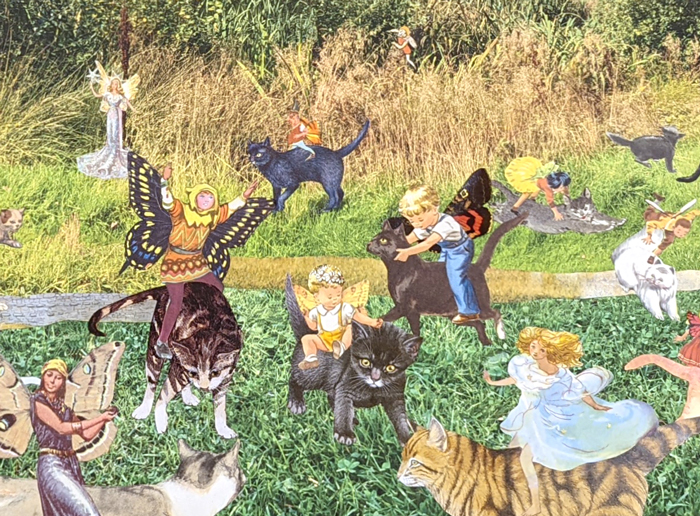
16.5″x32.25″; photographs taken at “Fairy Knowe”, collaged found images, glue stick and bits of Scottish cat hair; 2022. Courtesy of the artist.
Kolaj Institute’s Folklore & Collage Project
Through a series of residencies, exhibitions, and publications, Folklore & Collage considers the role artists play in activating, transmitting, and celebrating folklore in communities as a form of cultural expression and a strategy for community resilience. Learn more about Kolaj Institute’s Folklore & Collage Project.
